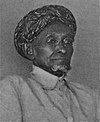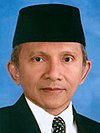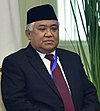| Persyarikatan Muhammadiyah | |
 Insignia of Muhammadiyah Insignia of Muhammadiyah | |
 Flag of Muhammadiyah Flag of Muhammadiyah | |
| Formation | 18 November 1912 |
|---|---|
| Type | Islamic organization |
| Purpose | Socio-religious, economics, education, and health |
| Headquarters | Yogyakarta and Jakarta, Indonesia |
| Region served | Indonesia |
| Membership | 28 million |
| Chairman | Haedar Nashir |
| Secretary-general | Abdul Mu'ti |
| Publication | Suara Muhammadiyah |
| Affiliations | Sunni Islam (Islamic modernism) |
| Website | en |
Muhammadiyah (Arabic: محمدية, romanized: Muḥammadiyyah, lit. 'followers of Muhammad'), officially Muhammadiyah Society (Indonesian: Persyarikatan Muhammadiyah) is a major Islamic non-governmental organization in Indonesia. The organization was founded in 1912 by Ahmad Dahlan in the city of Yogyakarta as a reformist socioreligious movement, advocating ijtihad - individual interpretation of Qur'an and Sunnah, as opposed to Taqlid - conformity to the traditional interpretations propounded by the ulama. Since its establishment, Muhammadiyah has adopted a reformist platform mixing religious and secular education, primarily as a way to promote the upward mobility of Muslims toward a 'modern' community and to purify Indonesian Islam of local syncretic practices. It continues to support local culture and promote religious tolerance in Indonesia, while a few of its higher education institutions are attended mostly by non-Muslims, especially in East Nusa Tenggara and Papua provinces. The group also runs a large chain of charity hospitals, and operated 128 universities as of the late 1990s.
At the time of Dahlan's death in 1923, the organization reported a membership of 2,622 men and 724 women, mostly residents of Yogyakarta. Numbers grew steadily — 10,000 in 1928, 17,000 in 1929, and 24,000 in 1931. By the 1930s, moreover, it had begun to establish branches beyond Java, the main center of population, throughout Indonesia, and today it is said to be the second largest Islamic organization in Indonesia (behind Nahdlatul Ulama) with 29 million members in 2008. The membership is largely urban and middle class in composition. Although Muhammadiyah leaders and members are often actively involved in shaping the politics in Indonesia, Muhammadiyah is not a political party. It has devoted itself to social and educational activities.
History

On November 18, 1912, Ahmad Dahlan— a court official of the kraton of the Yogyakarta Sultanate and an educated Muslim scholar from Mecca—established Muhammadiyah in Yogyakarta. There were a number of motives behind the establishment of this movement. Among the important ones are the backwardness of Muslim society and the penetration of Christianity. Ahmad Dahlan, much influenced by Egyptian reformist Muhammad Abduh, considered modernization and purification of religion from syncretic practices were very vital in reforming this religion. Therefore, since its beginning Muhammadiyah has been very concerned with maintaining tawhid and refining monotheism in society.
From 1913 to 1918, Muhammadiyah established five Islamic Schools. In 1919 an Islamic high school, Hooge School Muhammadiyah was established. In establishing schools, Muhammadiyah received significant help from the Budi Utomo, an important nationalist movement in Indonesia in the first half of the twentieth century, which provided teachers. Muhammadiyah has generally avoided politics. Unlike its traditionalist counterpart, the Nahdlatul Ulama, it never formed a political party. Since its establishment, it has devoted itself to educational and social activities.

In 1925, two years after the death of Dahlan, Muhammadiyah only had 4,000 members but had built 55 schools and two clinics in Surabaya and Yogyakarta. After Abdul Karim Amrullah introduced the organisation to the Minangkabau people, a dynamic Muslim community, Muhammadiyah developed rapidly. In 1938, the organisation claimed 250,000 members, managed its 834 mosques, 31 libraries, 1,774 schools, and 7,630 ulama. Minangkabau businesspeople spread organization to the entire of Indonesia.
During the 1965-66 political turbulence and violence, Muhammadiyah declared that the extermination of the Communist Party of Indonesia constituted Holy War, a view endorsed by other Islamic groups. (See also the Indonesian mass killings of 1965–66). During the events surrounding the 1998 fall of Suharto, some parts of Muhammadiyah urged the leadership to form a party. Therefore, the leadership, including Muhammadiyah's chairman, Amien Rais, founded the National Mandate Party. Although gaining large support from Muhammadiyah members, this party has no official relationship with Muhammadiyah. The leader of Muhammadiyah said the members of his organisation are free to align themselves with political parties of their choosing, provided such parties have shared values with Muhammadiyah.
In 2008, with 29 million members, Muhammadiyah was the second-largest Muslim organization in Indonesia, after Nahdlatul Ulama.
Doctrine
Muhammadiyah follows the Athari school of Sunni Islam, accepting only taking naqli (scripturalist) and rejecting all aqli (rationalist) tendencies. It emphasizes the authority of the Qur'an and the Hadiths as supreme Islamic law that serves as the legitimate basis of the interpretation of religious belief and practices. This is contrasted with traditional practices where shariah law is invested in religious schools by ulema. The main focus of the Muhammadiyah movement is to heighten people's sense of moral responsibility, purifying their faith to true Islam. Theologically, Muhammadiyyah adheres to doctrines of Salafiyya; calling for directly returning to the Qur'an and Sunnah and the understanding of the Imams of the Salaf (early generations), including the eponyms of the four Sunni Madh'habs (legal schools). It advocates for a purification of faith from various local customs which they consider to be superstitious, heretical and forms of shirk (polytheism). Muhammadiyya directly traces its scholarly heritage to the teachings of Muhammad Rashid Rida (d. 1935 C.E / 1354 A.H), Muhammad ibn 'Abd al-Wahhab (d. 1792 / 1206 A.H), and the medieval theologians Ahmad Ibn Taymiyyah (d. 1328 C.E / 728 A.H) and Ibn Qayyim (d. 1350 / 751 A.H).
Muhammadiyah strongly opposes syncretism, where Islam had coalesced with animism (spirit worship) and with Hindu-Buddhist elements that were spread among communities from the pre-Islamic period. Muhammadiyah opposes the tradition of Sufism that allows a Sufi leader (shaykh) to be the formal authority over Muslims. As of 2006, the organization was said to have "veered sharply toward a more conservative brand of Islam" under the leadership of Din Syamsuddin the head of the Indonesian Ulema Council. However, some factions of Muhammadiyyah tend to espouse the modernist movement of Muhammad Abduh rather than the Salafi doctrines of Rashīd Rîdá; which has been described as "rigid and conservative". Muhammadiyah refused to condemn LGBT people, because it believes that publicly condemning people affiliated with those identities and orientations would not help them "return to normalcy".
Activities

Muhammadiyah was noted as a Muslim reformists organization. Its main activities are religious practice and education. It has built modern Islamic schools, differing from traditional pesantren. Some of its schools are also open to non-Muslims. In 2006 there were around 5,754 schools owned by Muhammadiyah.
It also functioned as a charitable organization involved in health care. In 2016, it owned several hundred non-profit medical clinics and hospitals across Indonesia. In 2006, it was active in campaigning about the danger of bird flu in Indonesia.
Universities
Muhammadiyah has a number of universities which are spread out in several provinces of Indonesia, such as:
- Ahmad Dahlan University of Yogyakarta (UAD)
- Muhammadiyah University of Malang (UMM)
- Muhammadiyah University of Yogyakarta (UMY)
- Muhammadiyah University of Surakarta (UMS)
- Muhammadiyah University of Karanganyar (UMUKA)
- Muhammadiyah University of Purwokerto
- Muhammadiyah University of Makassar (Unismuh)
- Muhammadiyah University of Magelang (UMMGL)
- Muhammadiyah University of Semarang
- Muhammadiyah University of Metro
- Muhammadiyah University of Palembang
- Muhammadiyah University of Bengkulu
- Muhammadiyah University of West Sumatra
- Muhammadiyah University of North Sumatra
- Muhammadiyah University of Aceh
- Muhammadiyah University of Cirebon
- Muhammadiyah University of Bekasi
- Muhammadiyah University of Purworejo
- Muhammadiyah University of Surabaya
- Muhammadiyah University of Sidoarjo
- Muhammadiyah University of Gresik
- Muhammadiyah University of Jember
- Muhammadiyah University of Kupang
- Muhammadiyah University of Ternate
- Muhammadiyah University of Gorontalo
- Muhammadiyah University of Jakarta
- Muhammadiyah University of Prof. Hamka (UHAMKA)
- Muhammadiyah University of Parepare
- Muhammadiyah University of Sukabumi
- Muhammadiyah University of Ponorogo
- Muhammadiyah University of Pontianak
- Muhammadiyah University of East Kalimantan (UMKT)
- Muhammadiyah University of Sorong
- Muhammadiyah University of Mataram
- Muhammadiyah University of Bima
- Universiti Muhammadiyah Malaysia (UMAM) Padang Besar, Perlis
Suara Muhammadiyah
Main article: Suara MuhammadiyahMuhammadiyah also published their own magazine called Suara Muhammadiyah (English: The Voice of Muhammadiyah). Initiated by founder Ahmad Dahlan himself, it was first published in 1915, making it one of the oldest publications in Indonesia. Its contents consist of information on the doctrine of the movement and reporting on Muhammadiyah's activities.
Organization

The national headquarters was originally in Yogyakarta. However, by 1970 the committees dealing with education, economics, health and social welfare had been relocated to the national capital, Jakarta.
Muhammadiyah is supported by several autonomous organizations:
- Aisyiyah (women)
- Pemuda Muhammadiyah (youth)
- Nasyiatul Aisyiyah (women's youth)
- Ikatan Pelajar Muhammadiyah (students)
- Ikatan Mahasiswa Muhammadiyah (college/university students)
- Tapak Suci Putera Muhammadiyah (pencak silat martial arts)
- Hizbul Wathan (scouting).
The central committee structure consists of five advisors, a chairman with several deputies, a vice chairman, a secretary general with some deputies, and a treasurer with some deputies.
List of leaders
| Number | Photo | Name | Term Start | Term End | Deliberation Place | Description |
|---|---|---|---|---|---|---|
| 1. |  |
K. H. Ahmad Dahlan | 1 August 1912 | 23 February 1923 | Yogyakarta | Meetings 1st Year |
| 2. |  |
K. H. Ibrahim | 23 February 1923 | 13 October 1932 | Yogyakarta | Meetings 12th Year |
| 3. |  |
K. H. Hisjam | 10 November 1934 | 20 May 1936 | Yogyakarta | Meetings 23rd Year |
| 4. |  |
K. H. Mas Mansoer | 25 June 1937 | 25 April 1942 | Yogyakarta | Meetings 26th Year |
| 5. |  |
Ki Bagoes Hadikoesoemo | 24 November 1944 | 4 November 1953 | Yogyakarta | Emergency Congress |
| 6. |  |
Ahmad Rasyid Sutan Mansur | 4 November 1953 | 25 March 1959 | Purwokerto | The 32nd Congress |
| 7. | K. H. M. Yunus Anis | 25 March 1959 | 3 June 1962 | Palembang | The 34th Congress | |
| 8. |  |
K. H. Ahmad Badawi | 3 June 1962 | 25 April 1968 | Jakarta | The 35th Congress |
| 9. |  |
K. H. Faqih Usman | 25 April 1968 | 3 October 1968 | Palembang | The 34th Congress |
| 10. | K. H. Abdul Rozak Fachruddin | 3 October 1968 | 17 March 1971 | Fait Accompli | ||
| 17 March 1971 | 15 December 1990 | Makassar | The 38th Congress | |||
| 11. |  |
K. H. Ahmad Azhar Basyir | 15 December 1990 | 28 June 1995 | Yogyakarta | The 42nd Congress |
| 12. |  |
Prof. Dr. H. Amien Rais | 28 June 1995 | 26 April 1998 | Banda Aceh | The 43rd Congress |
| 13. |  |
Prof. Dr. H. Ahmad Syafi'i Ma'arif | 26 April 1998 | 31 May 2000 | Tanwir & Meetings Plenary Session | |
| 31 May 2000 | 25 November 2005 | Jakarta | The 44th Congress | |||
| 14. |  |
Prof. Dr. K. H. Din Syamsuddin, M.A. | 31 August 2005 | 8 July 2010 | Malang | The 45th Congress |
| 8 July 2010 | 6 May 2015 | Yogyakarta | The 46th Congress | |||
| 15. |  |
Prof. Dr. K. H. Haedar Nashir, M.Si. | 7 May 2015 | 19 November 2022 | Makassar | The 47th Congress |
| 19 November 2022 | Incumbent | Surakarta | The 48th Congress |
See also
References
- Nashir M. Si, Dr. H Haidar (2015). MUHAMMADIYAH: A REFORM MOVEMENT. Jl. A Yani Pabelan Tromol Pos 1 Kartasura Surakarta 57102 Jawa Tengah – Indonesia: Muhammadiyah University Press. p. 94. ISBN 978-602-361-013-6.
From aqidah standpoints, Muhammadiyah may adhere Salafi , as stated by Tarjih in Himpinan Putusan Tarjih (wy: 11), that Muhammadiyah promotes the belief principles referring to the Salaf (al-fi rqat al-najat min al-Salaf).
{{cite book}}: CS1 maint: location (link) - ^ A. Jalil Hamid, Tackle the rising cost of living longer . New Straits Times, 30 October 2016. Accessed 1 November 2016.
- ^ "Muhammadiyah". Div. of Religion and Philosophy, St. Martin College, UK. Archived from the original on 2008-09-14. Retrieved 2008-08-28.
- ^ Abu Zayd, Nasr (2006). Reformation of Islamic Thought. Amsterdam University Press. ISBN 9789053568286. Retrieved 20 April 2016.
- Pieternella van Doorn-Harder, WOMEN SHAPING ISLAM: Reading the Qu'ran in Indonesia, pg .95. Champaign: University of Illinois Press, 2010. ISBN 9780252092718
- Peacock 1978, 45
- Israeli 1982, 191
- Europa Publications Limited
- Burhani (2005), p. 101.
- "Short History of Persyarikatan Muhammadiyah". Muhammadiyah. Archived from the original on 2007-03-19. Retrieved 2006-08-10.
- Burhani (2010), pp. 65-66
- Ricklefs, M.C. (1991). A History of Modern Indonesia 1200-2004. London: MacMillan. p. 356.
- Ricklefs, M.C. (1991). A History of Modern Indonesia 1200-2004. London: MacMillan. p. 357.
- Ricklefs (1991), p. 288.
- "Muhammadiyah Makes Overtures to Islamists". Indonesia Matters. Retrieved 2006-08-10.
- Abu Fayadh, Faisal (23 July 2021). "Ustadz Adi Hidayat: Kita Semua Salafi" [Ustadz Adi Hidayat: We are all Salafis]. Retizen. Archived from the original on 23 July 2021.
- "Muhammadiyah Itu Golongan Ahlus Sunnah was Salafiyyah" [Muhammadiyah The Ahlus Sunnah was Salafiyyah]. Pwmu. 3 November 2017. Archived from the original on 18 October 2021.
- Muhtaroom, Ali (August 2017). "The Study of Indonesian Moslem Responses on Salafy- Shia Transnational Islamic Education Institution, Shiashia". Ilmia Islam Futuria. 17 (1): 73–95. doi:10.22373/jiif.v17i1.1645 – via Research Gate.
the development ofSalafi in Indonesia has inspired the emergence of anumber of organizations reformers of modern Islam in Indonesia. Organizationssuchas Muhammadiyah, Al-Irsyad,shared similar intentions to purify faith with the call back to the Quran and Sunnah, and leave many traditional customs that are claimed to be contaminated by heresy,tahayyul, and superstition... For Muhammadiyah, the purification of faith and the return to the Quran and Sunnah is an obligation... Muhammadiyah doctrine theology agrees with salafi, namely puritanist by going back to Al-Quran and As-Sunnah...
- In Indonesia, Islam loves democracy| Michael Vatikiotis | New York Times |6 February 6, 2006
- NASHIR, M. Si, DR. H. HAIDAR (2015). MUHAMMADIYAH: A REFORM MOVEMENT. Jl. A Yani Pabelan Tromol Pos 1 Kartasura Surakarta 57102, Jawa Tengah – Indonesia: Muhammadiyah University Press. p. 94. ISBN 978-602-361-013-6.
{{cite book}}: CS1 maint: location (link) - "National scene: Muhammadiyah takes soft approach on LGBT - the Jakarta Post".
- "USINDO Roundtable With the Muhammadiyah and Aisyiyah Delegation". The US-Indonesian Society. Archived from the original on August 13, 2006. Retrieved 2006-08-10.
- "Muhammadiyah urged Governot to Set Model School". Tribun Timur. Archived from the original on 2007-09-27. Retrieved 2006-08-10.
- "Muhammadiyah to help campaign on danger of avian flu". Antara. Retrieved 2006-08-10.
- "Tentang Suara Muhammadiyah - Suara Muhammadiyah". web.suaramuhammadiyah.id (in Indonesian). 2020-04-02. Retrieved 2024-02-26.
- "Profil Muhammadiyah".
- "Autonomous Organizations". Muhammadiyah. Archived from the original on 2007-09-27. Retrieved 2006-08-10.
- "Central Organization". Muhammadiyah. Archived from the original on 2007-03-24. Retrieved 2006-08-10.
Further reading
- Pacific Affairs, Vol. 27, No. 3 (Sep., 1954), pp. 255-263 Modern Islam in Indonesia: The Muhammadiyah After Independence
- Ali Shodiqin, Mochammad. 2014. "Muhammadiyah itu NU!: Dokumen Fiqh yang Terlupakan". Jakarta: NouraBooks.
- Burhani, Ahmad Najib. 2005. "Revealing the Neglected Missions: Some Comments on the Javanese Elements of Muhammadiyah Reformism." Studia Islamika, 12 (1): 101–129.
- Burhani, Ahmad Najib. 2010. Muhammadiyah Jawa. Jakarta: Al-Wasat.
- Peacock, J.L. (1978). Purifying the Faith: The Muhammadijah Movement in Indonesian Islam. Cummings Press.
- "Muhammadiyah". Div. of Religion and Philosophy, St. Martin College, UK. Archived from the original on 2008-09-14. Retrieved 2006-08-28.
- Ricklefs, M.C. 1991. A History of Modern Indonesia since c.1300. 2nd Edition, Stanford: Stanford University Press. ISBN 0-333-57690-X